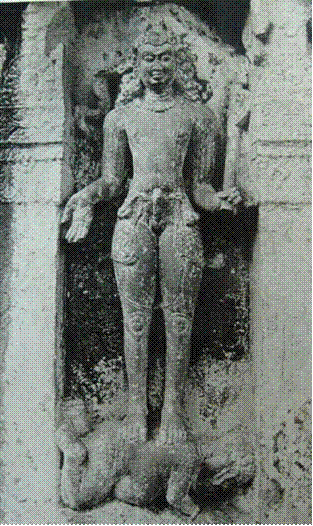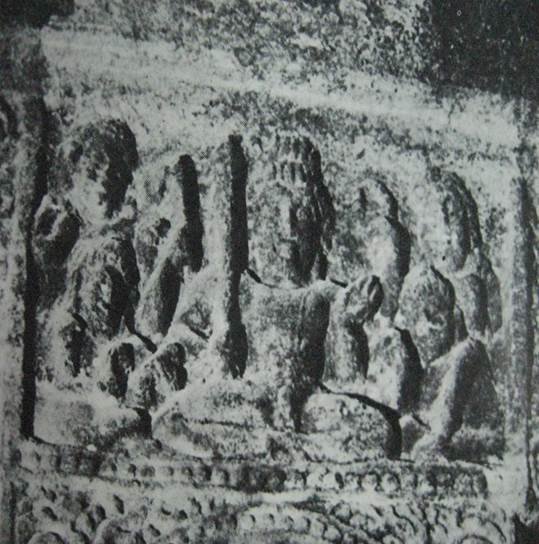Lakulisha-Pashupata (Philosophy and Practice)
by Geetika Kaw Kher | 2012 | 86,751 words
This study discusses the dynamics between the philosophy and practice in the Lakulisha-Pashupata order. According to the cave temples of Elephanta and Jogesvari (Jogeshwari), Lakulisa was the 28th incarnation of Shiva, and Pashupata Shaivism his doctrine, of which the Pasupatasutra represents the prominent text detailing various ritual practices (v...
Kalamukhas: The politically organized Saivite ascetics
[Full title: The Nexus between Pasupata ascetics and Royalty: Kalamukhas: The politically organized Saivite ascetics]
The Kalamukhas are said to have descended from the third disciple of Lakulisa, Kaurusa.or Karuka and they inhabited the Karnataka region mainly between 11th-13th CE.Both Ramanuja and Kesava Kashmiri substitute Kalanana by Karuka Siddhanta. Thus Bhandarkar[1] rightly considers both to be identical and the contention is further confirmed by an inscription dated 1177CE which claims that Kalananas were professing Lakulagama Samaya. A stronger proof is provided by Ammaraja’s Tadikonda Inscription[2] where the history of the Kalamukha saints is traced back to Lakulisa.. It states that Ramesvara Pandita, the preceptor of the early Kakatiyas, was the head of the Silamatha of the Kalamukhas of Srisailam and is described as the master of the doctrine of Lakulisvara.
Judging from the large number of epigraphs recording donations to Kalamukha temples and mathas these ascetics must have wielded considerable influence in the region. These epigraphical evidences reveal the existence of at least two major divisions of the Kalamukha order-the Sakti Parisad and the Simha-Parisad. Records of the latter division have been found over a wide area including various parts of Andhra Pradesh and Mysore.As Lorenzen[3] [4] observes(p 97), approximately 65 inscriptions from 18 Sakti-Parisad temples have been found and published and point at their tremendous power and position in the State.That these ascetics had their own land and armies further strengthen the contention that they were almost running a parallel government and had kings completely in their sway.
Interestingly saint Lagasipu, the founder of the Simhaparisad at Bezwada had actually “Pasupati” as the suffix to his name.
Pre Kalamukha Lakulisa-Pasupata activity in South India:
Even before these Kalamukha ascetics assumed great power in the region, the area had been a stronghold of Pasupata Saivism. Gudimallam linga and its formalistic affinity with Karvan lingas prove the antiquity of the Pasupata thought in the region. The 3rd -4th CE image found from Mukhalingam depicts a man with a club in his left hand, usnisa on his head and wearing a yajnopavita is identified as an early form of Lakulisa though the third eye and erect phallus are missing. From 7th CE onwards standing figures of Lakulisa ar e seen from various places in Karnataka. The tradition extends from the image at Sangamesvara temple at Kudavelly to the images on the walls of the temples at Mahakut and Mallikarjuna temple at Pattadakkal. Interestingly in such figures Lakulisa is represented like a Yaksa standing on the body of a dwarf, very much like Guddimallam linga.

[Illustration 24. Lakulisa,SangamesvaraTemple Chalukya,Mahakut,Karnataka, 6th CE]
An interesting four armed image of Lakulisa can be seen from Badami cave 1.

[Illustration 25.Lakulisa on a Pillar, Badami, Chalukya, Karnataka, 6th CE]
Sakti Parisasd:
The most prominent division of Kalamukhas was centered in the Kedaresvara temple at Belgave in Shimoga district. Almost 50 out of 65 epigraphs refer to this line of ascetics. Most of the records found at this temple have been edited and translated by B.L Rice in EC Vol VIII and collated by Lorenzen[5] . This line of ascetics, who also controlled various other temples in the region has been studied initially by J.F Fleet[6] (Inscriptions at Ablur, EI,VC 1898-99 213-65) and also by a local scholar A. Venkata Subbiah[7]
The full name of the form of Siva who presided over the Belgave temple was “Daksina Kedaresvara”, alluding somewhere to the Kedar in North India and hinting at the possible migration of this line of ascetics from North India. These ascetics were considered as “an ornament to Lakula [8] Samaya”(doctrine) and the list of subjects studied at the Matha in addition to all traditional Sanskrit texts included “Lakula Siddhanta” and “Patanjali Yogasutra”.
So while on one hand it links this very powerful group of ascetics to Lakulisa, on the other it points at Kedarnath, the important pilgrimage spot in North India to be considered as an important center of worship for them.
Several Kalamukha priests in Mysore bore the name “Kasmira Pandita”and this fact led Subbiah to assert that the Kalamukha sect originated in Kashmir. The contention was further substantiated by an inscription from Muttagi in Bijapur district dated to 1147CE.The record eulogises a line of Saivite priests who had migrated from Kashmir and had settled in Bijapur. The priesthood is clearly identified by Desai as a Kalamukha one which has also been mentioned in a grant of 1074-75 found from Bijapur itself[9] . (Ed and Trans. By J.F Fleet,). As comes across in the inscription, the priests seem to belong to “Bhujangavali” another branch of Sakti Parisad and interestingly two main ascetics of this branch are named as “Kasmira Pandita” and “Lakulisvara”.
Now the migration from Northern parts to South does not come as a surprise, especially in 11th-12th CE when both Northern and Western parts of India was continuously grappling with Islamic invasions. One only has to read the history of Somanath temple in Gujarat and its repeated plundering to understand the gravity of the issue, especially for the ascetics linked with various Mathas and temples.
As Lorenzen35 also observes:
“Many parts of North-Western India were being rocked by the incursions of Mahmud of Ghazni at about this time and this may also have been a factor in the move to the South.”
Significantly Lorenzen talks at length about the lineage of an Kalamukha Acarya, “Bhujanga” who migrated from Kashmir. This lineage comes across as very important and mystic branch settled around Bijapur with many similarities with Nath Siddha cult and many of its ascetics were supposed to possess various Siddhis. In 107475CE, a governer of Somesvara II of Kalyana Calukyas built a temple dedicated to lord “Sri Svayambhu Siddhesvara” for an ascetic Yogesvara and his pupils who hailed from Bhujanga’s lineage. Moreover it is recorded that some land too was dedicated to these Acaryas for the upkeep of the temple. Apart from being experts in Vedic knowledge these Acaryas were very well versed in Lakula shastra and their aim was to attain “Bhairavahood”, very much like Abhinavagupta and his followers.
These teachers were favored and held in high esteem by Kriyasaktis, a powerful group of Kalamukha priests of Sakti Parisad, who are known to have been royal preceptors of Vijaynagara kings and are given the titles of “Rajguru” and “Kulaguru”. Few sources imply the existence of a close relation between these Kriyasaktis and the Advaita gurus of the famous Sringeri Matha founded by Samkaracarya after coming back from Kashmir somewhere in 8th CE[10] .One of these Kriyasaktis is said to have induced his disciple “Madhava-mantrin to give a village to eighty learned Brahmanas from Kashmir. This alludes to the importance and growing power of these north Indian ascetics in Southern kingdoms.
On trying to trace these ascetics to their roots in Kashmir and other places in north India one is usually faced with paucity of verbal as well as visual evidence. Saivism in Kashmir, especially post Abhinavagupta,10th CE, became more philosophical and gradually lost touch with rituals. Later on imbibing the Trika doctrine it became more intellectual and present day Saivism is known for it’s profound insight in philosophy and psychology rather than the practice which took a back seat.. Unfortunately not much has survived to suggest the importance and extent of Lakulisa order in Kashmir, but the fact that Abhinavagupta, the 10th century AD philosophical giant, grants the school a position next only to his highly evolved system, speaks of its importance.[11]
There are multiple clues to suggest that Kashmir was home to a more rustic and ritual oriented Saivite thought which seem to have a strong Lakulisa-Pasupata origin.
Footnotes and references:
[1]:
Bhandarkar R.G “Vaisnavism and Saivism and Minor Religious Systems”,Poona, 1928, p.54
[2]:
Ammaraja Tandikonda Inscription, EI, XXIII, p161-170
[4]:
p.97
[5]:
Lorenzen Daved p.96-100
[6]:
Fleet J.F. “Inscriptions at Ablur, EI,VC 1898-99,p. 213-65
[7]:
Subbiah,A.Venkata “A twelth century University in Mysore, Quaterly Journal of the Mythic Society, Bangalore, VIII (1917) p.157-96
[8]:
Lorenzen David, p,98
[9]:
Fleet J.F.,Ed and Trans. “Sanskrit and Old Canarese Inscriptions, IA,X (1881) p. 126-13135Lorenzen David, 108
[10]:
Ibid p.132
[11]:
Pandey K.C “Abhinavagupta, A historical and philosophical study,MLBD, Delhi, 2000
